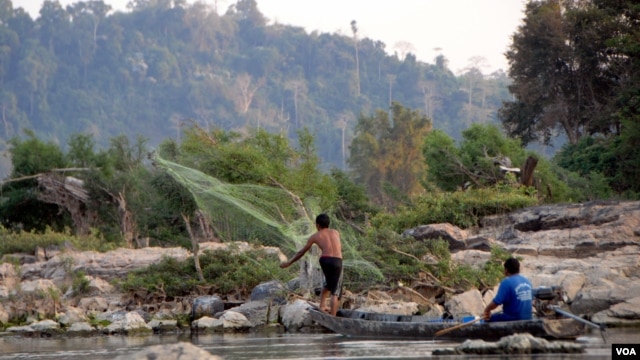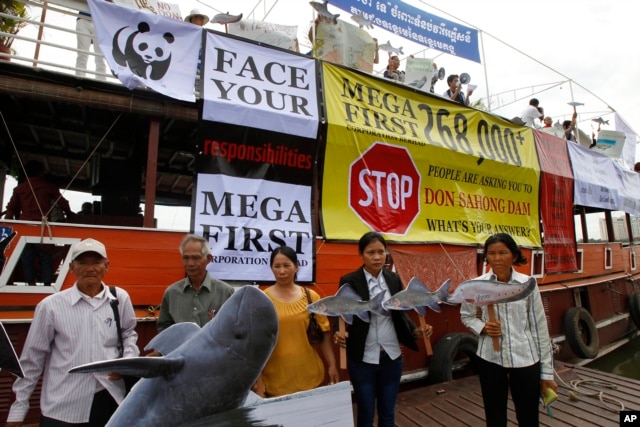Cambodian Activists Want Laos Dam on US-ASEAN Agenda
VOA | 10 February 2016

PHNOM PENH, CAMBODIA—Civil society
groups are calling for Laos’ Don Sahong hydropower dam project to be
discussed when Southeast Asian leaders meet with President Barack Obama
next week at the Sunnylands estate in Rancho Mirage, California.
The unprecedented U.S.-hosted ASEAN summit comes amid increased
efforts by the Obama administration to increase its security and
economic presence in the region, where it wants to balance the influence
of a rising China.
Environmental campaigners in Cambodia said the two-day meeting, which
kicks off February 15, provides members of the Association of Southeast
Asian Nations the opportunity to appeal for American assistance or
mediation on the awkward issue of hydropower on the Mekong River, the
lower reaches of which have not yet been dammed.
Nongovernmental organizations expressed this hope to U.S. Secretary of State John Kerry on his visit to Cambodia last month.
FILE
- Cambodian nongovernmental organization activists hold a cutout of a
Mekong dolphin, left, and cutout of other species during a protest
against the proposed Don Sahong dam, in Phnom Penh, Cambodia, Sept. 11,
2014.
Of immediate concern for these groups is the plan to construct the
260-megawatt Don Sahong facility at a site in southern Laos, just 1.5
kilometers from the Cambodian border. The governments of both Cambodia
and Vietnam have raised concerns about the potential impacts downstream,
where millions of people rely on the Mekong’s fish for protein.
Chhith Sam Ath, country director for the World Wildlife Fund in
Cambodia, said dam construction should at least be suspended while Lower
Mekong countries discuss the issue.
"Cambodia has Irrawaddy dolphins in the Mekong, which may swim back
and forth between Cambodia and Laos," he told VOA Khmer. "It also is one
of the countries in Asia that has the most fish. These fish contain
protein that supports millions of people."
Beyond providing basic sustenance for locals, the Mekong River draws
tourism that, he said, could be threatened if damming disrupted the
river’s delicate ecosystem.
"We are worried that the Don Sahong dam will affect our efforts to
protect dolphins, as well as about fish migration, water quality and the
livelihoods of millions of people," Sam Ath said.
Laos [of revived "Indochina" controlled by Vietnam] "already is constructing the Xayaburi dam along the main body of
the Mekong River, where it has proposed another 10 dams. Laos has pushed
ahead with the hydropower projects, despite opposition from the
downstream countries.
U.S.-funded initiative
While official protests have been lodged through the Mekong River Commission, a multilateral body formed out of a 1995 agreement among Laos, Thailand, Cambodia and Vietnam, another multilateral mechanism might hold more hope for an effective intervention over Laos’ hydropower plans.
Founded in 2009, the U.S.-funded Lower Mekong Initiative targets
improved cooperation among the countries of the subregion, while
promoting environmental conservation of Mekong River wildlife and clean
water.
"We are working diligently to develop sustainable development
practices on the Mekong River," Kerry told reporters in Phnom Penh on
January 26. "And we have the Lower Mekong Initiative, which focuses on
many of these issues."
According to the U.S. State Department, the initiative’s programs
include the development of a tool to model the impacts of climate change
and other environmental challenges in the subregion.
Tek Vannara, director of the NGO Forum on Cambodia, said that while
60 million people rely directly on the Lower Mekong, 300 million live in
its periphery and should therefore be concerned about the potential
impacts of dams such as Don Sahong.
The U.S. government, he added, could use the Lower Mekong Initiative
to play an important role in creating an atmosphere in which the
countries along the river can talk constructively about the dam.
"We want the program to focus on energy development and environmental
protection," he said. "We want [the U.S.] to give us technical and
financial support, or a mechanism to preserve the Mekong River, because
protecting water resources and using water with equity can guarantee
food security in the Mekong region."
Luy Rasmey, executive director of the Culture and Environment
Preservation Association, which is based in Stung Treng, the Cambodian
province opposite the Don Sahong dam site, told VOA Khmer that local
communities’ concerns should be raised at next week's high-level
meeting. "[The dam] would have a lot of impact on the people who are
relying on the river resource," she said.



No comments:
Post a Comment